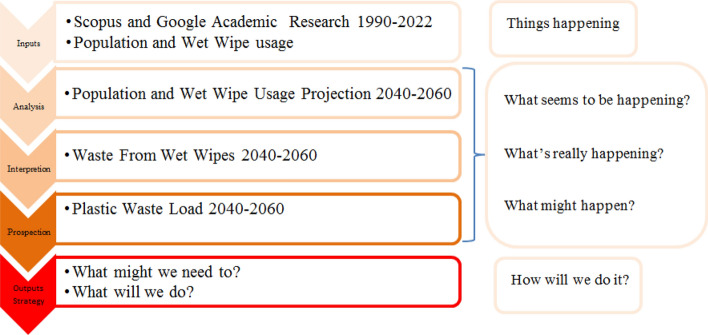Abstract
The vast use of wet wipes has now become a habitude, particularly following the altered perception of cleanliness during the pandemic and the encouragement towards using WW (wet wipe) to ensure parent’s and children’s hygiene. This study primarily aims to create a projection of the WW waste that will emerge in Turkey as a result of the promoted consumption by children who are predicted to retain the WW usage practices of their parents. In line with this habit adopted by children, the number of daily WW usage which is currently around 210 million is expected to rise to over 250 million between the years 2040 and 2060, depending on how the children are guided by their parent’s existing habits. In this study, related calculations were made with FT-IR spectroscopy, taking into account the functional bond structure and percentage distribution of polymers in WWs. In this way, it is detected that 360 T, 568 T, and 623 T polymer materials would be thrown into the environment per day in 2021, 2040 and 2060, respectively. The damage of chemicals in WW content, employed at various concentrations, to the ecosystem structure is predicted and measures to be taken are outlined.
Graphical abstract
Keywords: Non-woven textiles, Plastic pollution, Plastic awareness, Waste management, Polyester (PES), Polypropylene (PP), Microfiber
Introduction
Wet wipes (WWs) are among the products frequently used in our daily lives thanks to their ease of use. In fact, since the mid-2000s, WWs, particularly those produced for babies, have been used as an alternative to toilet paper in high-income countries [1]. In terms of various usage areas of WWs, they are used for personal hygiene in daily work to quickly clean hands and for baby care as they are usually favored by parents due to the wide range of applications. The same diversity also applies to the basic structures used in the WWs production phase. WWs are made up of a liquid component and non-woven surface fabric (natural and synthetic fiber) [2]. The natural non-woven fabric structure of WWs can be made of cellulose, jute, linen, hemp, and bamboo, whereas the artificial fiber part is produced from synthetic fibers such as polyester, polypropylene, polyamide, and polyethylene [3]. In addition, polyvinyl alcohol and polyolefins can also be used in the artificial fiber part. Water, softener, surfactant, pH balancer, skin protectant, perfumes, antibacterial or antiviral agents, and combinations thereof make up the liquid component of WWs [4, 5].
WWs are not made of tissue paper and do not degrade easily contrary to popular belief and people’s misperception of WWs [6]. The most commonly used polymers in the manufacture of commercially accessible WWs are defined as non-woven PET fibers [7]. In parallel, the global value of the medical non-woven market is expected to reach 1.61 billion US dollars by 2024, with an annual growth rate of approximately 4.6% [8]. These polymer structures, which are added to the more generally used WWs, degrade instantly within 10 to 90 s following rapid consumption, and these wastes may persist in nature for a long time in the form of microfibers [9, 10]. The research in the literature highlight that WW wastes are detected as micro/nano-plastics in a wide range of environments, including marine sediments [7] and fish stomach [11]. WWs also persist in sewage systems for a long time due to their synthetic fiber contents [12]. People are unaware of the contents of WWs they purchase; thus, the prevention of the disposal of these microplastic wastes before they become a potential source of environmental pollution in the coming years needs to be urgently addressed [13]. Having been settled into our daily usage patterns, such characteristics of WWs and substances used within have only recently begun to be disclosed publicly.
The use of WWs has now become a habit due to factors such as the COVID-19 pandemic and raising concerns about infectious diseases, increasing demand for cleaning due to the changing perception of hygiene, and the simplicity of WWs usage in childcare [14–17]. During the pandemic, parents’ ‘hygiene obsession for their children’, as well as the notion that WWs provide hygiene in a shorter time compared to using water and soap, were the key motivations that prompted the extensive use of WWs [18, 19]. In the Turkey Hand Washing Survey conducted by the Ministry of Health’s General Directorate of Health Improvement in 2012 [20], about 98.7% of the participants stated that they clean their hands with water. In addition, the use of WWs and paper towels for hand cleaning was determined as 5.2 and 5.7%, respectively. However, studies reveal that handwashing habits have gradually declined, while the use of WWs has surged in Turkey since 2012. The association of market research companies, WIN/Gallup International, reported that the prevalence of the habit of handwashing in Turkey was 94% in the handwashing habits survey conducted in 63 countries in 2020 [21]. In their study conducted on handwashing attitudes during the COVID-19 pandemic, Uğurlu et al. [22] found that the rates of water usage, WWs, and paper towels in hand cleaning were 92.4, 15.4, and 40.9%, respectively. Another study revealed that WWs are the third most popular private label personal care product purchased in Turkey [23].
As the WHO [19] reported that a proper hand cleansing requires about 40–60 s of contact with soap and water, it is a false perception that you can attain the same level of hygiene with WWs in a shorter time. Some recent studies have demonstrated that such an increase in the use of WWs stems from the newfound attention to hygiene as a result of the pandemic [13, 17]. However, this type of hygiene practice and the need for cleaning in a short time also appear to be a usage habit passed on to children through the practices of their parents. It is well established that the family, particularly the mother, is the most significant environmental factor influencing consumer behaviors that continue into adulthood [24]. Studies of early cognitive development also suggest that infants and young children are keenly responsive to what they can learn from the actions and words directed to them by others. Young children rely heavily on what they learn from others so much so that they become insightful, by the preschool years, in distinguishing adult speakers who are likely to provide them with reliable information from those who are not [25]. It is important to point out that these foundational theories are not simply isolated forms of knowledge but play a profound role in children’s everyday lives and subsequent education [26].
This study aims to present the WWs projection situation in Turkey emerging from children’s extensive consumption and disposal of WWs resulting in waste based on the assumption that children will follow their parents’ WW consumption patterns. To this end, a 4-stage study was designed: (i) population projections were taken as the basis for relevant age groups (ii) The number of WW usage for 20–40 years in the future and the minimum amount of waste generated was calculated, (iii) predictions were made on how the waste generation will be affected by the WW use of future parents instilling the acquired habits in their children. (iv) The polymer content of the most preferred WWs in Turkey was identified via FT-IR analysis to reveal the current and future environmental impact of WW wastes.
Materials and methods
Justification and flow chart of the study
Waste resulting from WWs, which we often favor in our daily lives due to their convenient use, accessibility, and quick consumption, is one of the most prevalent environmental challenges to be encountered. To identify the number of research articles published in international journals on the subject, the term ‘wet wipes’ was searched as a keyword in the Scopus database, and a total of 407 published research articles were found in the literature as of the year 1950. However, the number of studies carried out in the field of ‘environmental sciences’ was limited to only 63 (Fig. 1). Furthermore, it is noteworthy that studies on the risk assessment of WWs in the environment, particularly in the last 5 years, have concentrated only on the matters under the title of ‘the role and potential risk of WWs as a source of microplastic in the environment’. Studies conducted on the long-term effects of increasing WW usage on ecosystems have become increasingly prevalent. Hygiene habits, regulations for outdoor usage, and limits on water use in certain countries make the behavioral patterns acquired on the subject of WWs permanent. However, as presented in Fig. 1, the Scopus and Google Academic search for the focal points of research on WWs and the impacts of WWs usage amount on future generations yielded no research in the literature on the subject of the waste generation and environmental effects of WWs between the years 1990 and 2022. These findings demonstrate this study’s originality and serve as the primary justification per se.
Fig. 1.
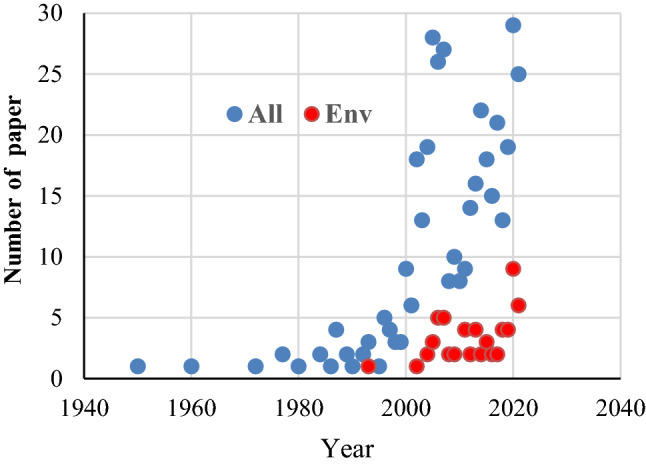
Distribution of the number of articles on the subject of WWs by year
According to Voros [27], foresight methodologies can be classified at four levels with different guiding questions. The working setup, grounded upon the foresight methodologies developed by Voros [27], is presented in Fig. 2.
Fig. 2.
Flow diagram of the study about the waste generation from WWs
Age groups and data source taken as a basis in the scenario
Information regarding the selection of the data set used for the scenario and the values accepted in the modeling are presented under the main headings. In these selections, for instance, the most widely used WWs in Turkey, the research data has been arranged following the applied model.
In line with the working scenario, children populations in the 0–4, 5–9, and 10–14 age groups living in Turkey were taken as a basis. Three separate age groups, in which the parent factor was forefront in developing a habit of using WWs were specifically chosen when determining the age groups. The hygiene needs of children aged 0–4, representing newborn and early childhood, are met by parents. Children of the 5–9 age range, a period in which children are very active, begin to socialize outside the family and interact with the outer environment. Children at this stage acquire their hygiene practices through observing their parents’ actions and patterns of material usage. Children aged 10–14, on the other hand, represent a distinct age group as they move from childhood into the early adolescence era, when parental communication fades but communication with peers and the environment starts to become significant [28]. Their habits become more permanent as a result of both their acquisitions and their interactions with the environment.
In this study, the 0–4 age group was considered as the particular group in which handwashing habits have not yet become established, parents use WWs for hand and body cleaning, and the highest amount of WW is consumed. Children between the ages of 5 and 9 are predicted to be the group that maintains their family habits as well as, to some extent, social habits. Children between the ages of 10–14, however, are regarded as a group that spends most of their time away from their parents, but they will behave in accordance with the habits they have acquired from their family and environment. The 14–54 age group is also included in the 2040 and 2060 projections as accustomed individuals.
The population data source for this study was statistics generated and published by TurkStat which uses records from the Address-Based Population Registration System (ADNKS) and the Central Population Administration System (MERNIS) as their main data sources. Population projections were made according to the cohort component method [29]. Along with population projections for the coming years, TUIK stores historical and current data according to the address-based population registration system as well. These data files are shared with open code on the statistical data portal [30]. This study employed statistics generated and published by TurkStat records as a data source.
Postulations about the use of WWs
In this section, numbers for WW usage were determined based on the year 2021 for three age groups (0–4, 5–9, 10–14) who have just begun to develop hygiene habits. Since parents are the primary determinants of WW use, the usage amount was determined through parental consulting (n = 98). The daily WW usage numbers for today’s 0–14 age group were determined by door-to-door interviews with mothers who have children in these age groups. The consulted mothers are in the 20–45 age range, have at least one child between the ages of 0–14, 28.6% are university graduates, 61.2% are high school graduates, and 10.2% are primary school graduates. Again, 50% of the mothers consulted are working and 50% are homemakers. The average daily WW use/standard deviation values for the 0–4, 5–9 and 10–14 age groups were obtained as 19.5/4.7, 9.4/1.7 and 8.5/1.5, respectively Dey et al. [31] determined the amount of diaper use by conducting door-to-door interviews with the mothers of the babies. In this study, based on the study of Dey et al. [31] the same method was used and scenarios were created by comparing and verifying the data.
Parents stated that they generally use WWs extensively for various purposes throughout the day for their children in the 0–4 age group, for babies’ anal cleansing in particular. According to Didişen et al. [32], about 45.5% of the mothers used WWs to clean their baby’s bottoms, and 34.5% used them for daily baby care during their stay in the hospital. Kurt [33] discovered that 82.9% of mothers used WWs to clean their children. In another study, Dey et al. [34] evaluated both gender and daily WW usage frequency in the 0–4 age group for children in Germany, England, and the United States, and found that WWs were used with a prevalence of 95%, with 14, 16 and 9.53 units of WWs being consumed per day, respectively. They also noted that as the months passed, the amount of WW usage decreased in this age group, and the frequency of cleaning the baby’s bottom area was 4–6 times per day. In Korea, Lee et al. [35] compared the use of WWs among infants aged between 0 and 36 months by season, and found that 9.39 ± 6.14 wipes/day were used in the winter season and 10.55 ± 6.42 wipes/ day were used in the summer. In England, the wipe usage was higher among infant males (11.2 wipes/day) than in infant females (9.3 wipes/day), especially in the 0–10 month age group. For the age group of 30–40 months, however, daily wipe usage was estimated as 7.0 for males and 5.0 for females. The model was found the same for both genders in Germany since there was no evidence of gender impact on the number of wipes used in the German data; nonetheless, as a common finding, the amount of wipe uses was found to decrease as age increased. As the daily usage consistently ranged from 5.8 to 9.5 wipes, neither age nor gender of children had a statistically significant impact on WW usage in the United States, most likely due to the smaller sample size of the study. However, in this study, the lowest limit of the amount of WW usage was calculated as an average of 16 wipes/day for the 0–4 age group, using scientific studies as a basis for numerical evaluation and in consideration of parents who do not prefer the use WWs and those who use them at every given opportunity.
While determining the WW use of different age groups, the data of door-to-door interviews with mothers having children of different ages were taken as the basis. Zhang et al. [36] found a positive relationship between usage frequency and family status, educational level, and personal monthly income; reporting that women use wet wipes more frequently than men. For all other age groups, it has been foreseen that at least eight WWs are consumed per day, based on the assumption that each person consumes two pieces of WW for basic hygiene needs in addition to one WW before and after each meal throughout the day. Both the population growth and the amount of WW usage in accustomed groups will increase in 2040 and 2060, Zhang et al. [36] reported that in parallel to improved living standards, consumers prefer to use disposable, clean, and useful wet wipes in daily life. However, the number of usage habits was kept to a minimum and the effect of WW amount on the cumulative solid waste amount in the projection scenario was kept at the lowest rate. Thus, possible changes in the scenario were reflected in other years at a minimum level. The main factor determining the decrease in the number of WW usage in age groups other than the 0–4 age group is the decrease in the dependence on individual toilet habits and the higher dependence of children on the mother in hygiene habits. While calculating the consumption for the year 2040, individuals in the 0–14 age group who acquired a habit of using WW in 2021 were considered parent candidates for 2040. Although the WW usage of individuals who form similar habits in their children will increase, the quantity in projection calculations is based on the lowest postulated usage. However, in the prediction for the year 2060, all age groups are assumed to have acquired WW usage habits and become accustomed to it, but the number of users is deemed to be the lowest, and calculations for projection were conducted accordingly (Table 1). With the scenario used in the study, it is expected that the changing habits of consumers will be emphasized and taken into consideration in waste management strategies.
Table 1.
Daily wet wipe usage
| Age groups | Wet wipe usage (number/day) | ||
|---|---|---|---|
| 2021 | 2040 | 2060 | |
| 0–4 | 16 | 18 | 20 |
| 5–9 | 8 | 9 | 10 |
| 10–14 | 8 | 9 | 10 |
| 20–24 | 4 | 8 | 8 |
| 25–29 | 4 | 8 | 8 |
| 30–34 | 4 | 8 | 8 |
| 40–44 | 2 | 6 | 8 |
| 45–49 | 2 | 6 | 8 |
| 50–54 | 2 | 6 | 8 |
WW waste and PES load calculation for scenario
Depending on the usage habits of the age groups (Table 1), the daily number of waste WW, the WW waste load, and the resulting minimum and maximum Polyester (PES) accumulation were calculated with the following formulas. The dry weights of the most preferred WWs in Turkey were weighed on precision scales and the average WW weight was determined. Besides, the PES content of WWs was determined by Fourier transform infrared (FT-IR) spectroscopy analysis. Calculations were made by assuming that the most preferred WWs contain a minimum of 30% and a maximum of 90% PES according to the results of FT-IR spectroscopy percentage polymer distribution.
-Number of WWs per day for age group = Number of persons in age group*Number of WW used per person per day
-WW waste for age group (T/day) = Number of WW per person per day for age group*Average WW weight
-Minimum PES accumulation (T/day) = WW waste for age group (T/day)*30%
-Maximum PES accumulation (T/day) = WW waste for age group (T/day)*90%
-Annual total waste of wet wipes (T/year) = Average number of WW per person*Population*365
-WW percentage in total household waste = Annual total waste of wet wipes (T/year)/Annual total amount of domestic waste (T/year)
FT-IR analysis of the most frequently used WW products
The most popular WWs among middle-income households were chosen. In other words, general-use WWs were analyzed according to the level of economic income and usage. The most commonly used three types of WWs, which differ by their usage areas, are those used for newborns, antibacterial WWs, and those used for general cleaning purposes. Selected samples were first dried and then analyzed in the central laboratory of Niğde Ömer Halisdemir University using the Bruker Vertex 70 FT-IR (Ettlingen, Germany) with a scanning range of 400–4000 cm–1. FT-IR spectroscopy, which was selected to determine the different polymers in the content of WWs, also identified the functional bond structure of WWs and the percentage distribution of polymers. Transmittance bands were recorded and compared to a pre-existing database. A minimum of four matching transmittance bands are required for the accepted identification of polymer materials [37].
Results and discussion
Scenarios by age
The yearly population growth rate in Turkey is anticipated to fall to 11.0 ‰ in 2025, according to TUIK data (Fig. 3). Correspondingly, the population growth rate is expected to decrease over the years, according to 2023, 2040, and 2060 population projections (Fig. 4) of TUIK based on the age groups. However, it is worth noting that Turkey has seen a significant influx of immigrants in recent years and the population of babies aged 0–4 years is growing rapidly. On the other hand, population increases due to migration factors have been neglected in the calculations in this study.
Fig. 3.
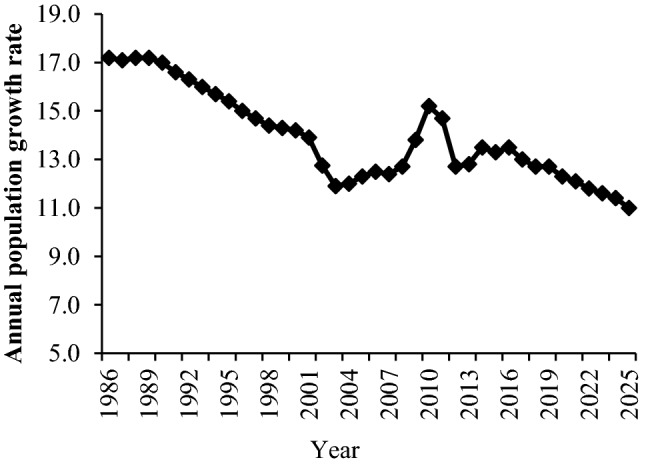
Annual population growth rate for TR
Fig. 4.
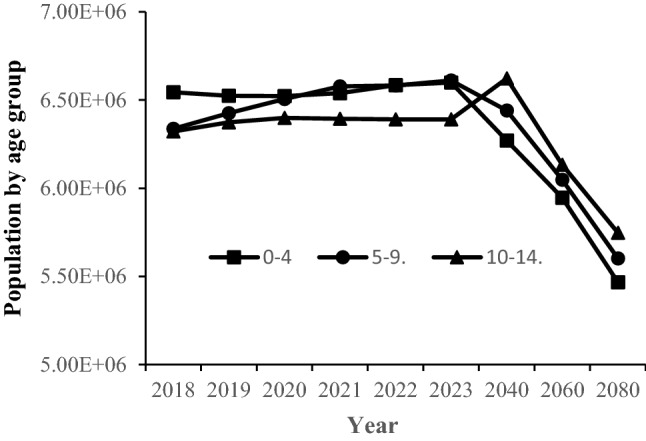
Population projection by age group
WW waste scenarios by age projections
The amount of WW waste to be generated in the present-day and future years was calculated by considering the population projections and daily consumption of WWs per capita by the 0–14 age group. First and foremost according to the assumption that 0–14 age groups have not yet developed the habit of using WW and they use WW based on parental habits, the number of daily WW uses for 2021 has been determined as 210 million. As shown in Fig. 5, with the acquisition of habits, these values are expected to reach up to approximately 250 million in the years 2040 and 2060 for the 0–14 age group. It is thought that the main reason for this increase is the wrong perception and usage habits that hygiene can be achieved in a shorter time with WWs. Although the population growth rate has decreased over the years, it is estimated that today’s 0–14 age group children, who will acquire the habit of using WW, will use WW more than today’s adults.
Fig. 5.
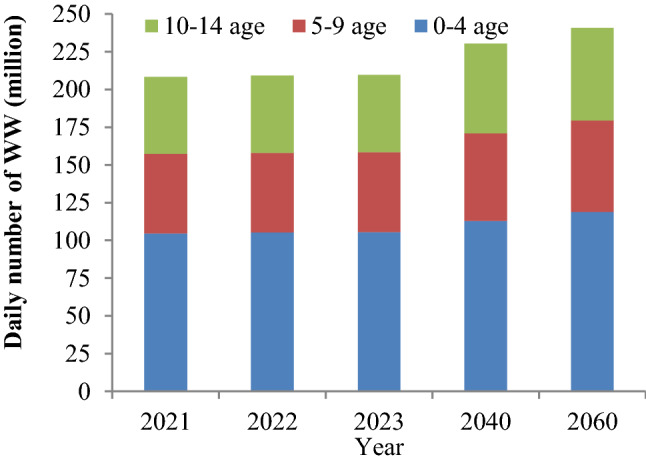
Daily number of WW used for age groups
While 260 tons of WW waste was produced per day due to the consumption of the 0–14 age group in 2021, the projection results, as presented in Fig. 6, predict that approximately 295 tons of daily WW waste will be produced until 2040 and 2060. According to WHO [19] reports, the use of WWs has increased in recent years, particularly during the COVID-19 pandemic. Concurrently, with the adoption of new consumption habits, it is expected that the amount of WW waste will increase even more in the coming years. Nielsen [38] reported that since the outbreak of COVID-19, Chinese residents have continuously improved their hygiene awareness as part of epidemic prevention and control requirements, resulting in a significant growth rate (41% in the first quarter) in the use of wet wipes. For this reason, it is thought that individuals who are habituated to using WW have a very high potential to continue these habits both in passing this habit down to future generations and in individual use.
Fig. 6.
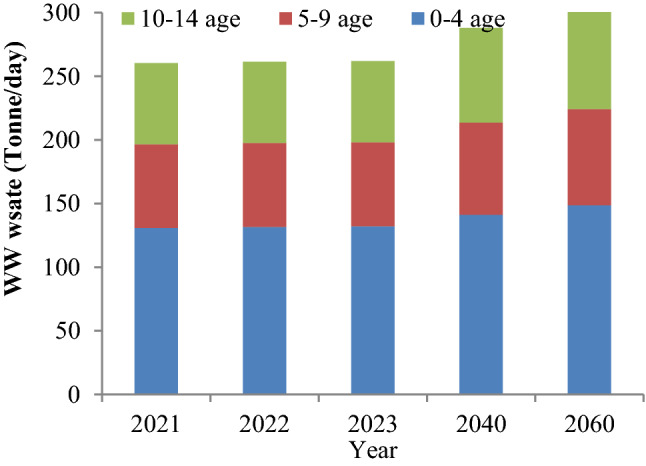
Weight of WW waste per day
When an evaluation is made for society as a whole, all age groups are determined to consume approximately 320 million WWs per day in 2021. Similarly, according to research carried out for the EU-28 countries, it was calculated that approximately 68 billion WWs were consumed annually in 2017 [39]. It was also reported that over 11 billion WWs were consumed in the UK each year [40].
Figure 7 presents the projection that today’s individuals will form the age group of the society up to 34 years old and will follow the same habits in 2040. Accordingly, it is observed that daily WW use will increase to approximately 500 million, and in 2060, when it becomes a habit between the ages of 0 and 54, will increase to 550 million. The increase in consumption patterns, despite the fall in population growth, will result in a rise in the amount of daily WW usage. Although the significance of the family diminishes as children approach adolescence, it is well recognized that perceptions acquired at an early age are determinants of behaviors [41]. With the prediction that today’s children in the 0–14 age group will be parents at 20–34 years old in 2040, it is plausible to argue that these parents will continue to prefer the use of WWs for both cleaning themselves, as well as for the hygiene needs of their children. IDs, for example; familial roles of parents or the recreational role of the active person may emerge as a reflection of the influence of society on the individual [42, 43]. For this reason, it is thought that the family is effective in forming the habits of children in social psychology [43]. Badur [44] stated that families play a significant role in guiding the consumption habits of their children, influencing their perception of brand and product selection; therefore, product loyalty is passed down from generation to generation. As a result, it is expected that WW use will rise in the 40–54 age group in 2060 together with other generations who have developed the habit of using WWs. This, in turn, will result in the emergence of a social structure in which the amount of waste generated will subsequently increase. At the same time, The Ministry of Health of the Republic of Turkey identified the rate of WW usage as 5.2% in the Turkey Hand Washing Survey and Uğurlu et al. [22] determined the WW usage rate as 15.4% in their research on handwashing habits during the COVID-19 pandemic, supporting the work of the Ministry of Health by clearly expressing that WW usage habits increased through generations subsequently to acquired habits.
Fig. 7.

Projection of daily number of WWs used by age groups
Individuals in the 0–54 age group who have not yet developed a habit of using WWs in 2021 generated around 400 T of WW waste per day and 146,000 T per year. The annual garbage production of municipalities in Turkey is approximately 33 million T and the amount of WW waste generated constitutes approximately 0.44% of the total mass. For EU-28 countries in 2017, WW waste per day was 511,000 T, based on an estimate of one kilogram of WW waste per capita each year [39]. Based on the premise that individuals in the age group of 0–34 have developed a habit of WW usage, 630 T/day of WW waste is projected for the year 2040. However, nearly 700 T/day of WW waste is projected for 2060, considering that all individuals in the 0–54 age group will have developed a usage habit by then as presented in Fig. 8.
Fig. 8.
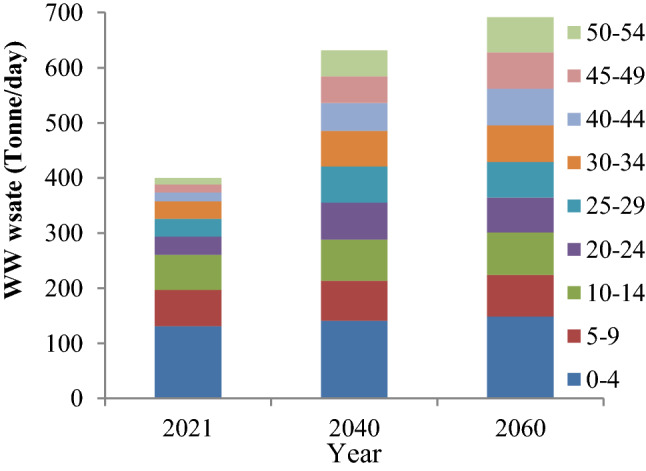
Weight of WW waste projection per day
To support the estimated rise in the use of WWs among the 0–4, 5–9, and 10–14 age groups in 2040 and 2060, it can be said that children in this age group currently are the parents of the coming years since it is well established that the most significant learning tool influencing children’s habits, successes, and behaviors in adulthood is the behavioral patterns of their parents [45]. The family, particularly the mother, is believed to be the most significant environmental factor influencing consumer habits that persist into adulthood [24]. Mothers’ use of WWs, particularly for anal, hand, and body cleansing for these age groups will lead to an increase in the habit of using WWs among children; in other words, among parents of the future.
Content-wise polymer accumulation scenarios by age and WW use
The polymeric substance utilized in the manufacturing of WWs may differ by the type of use [10]. The types of polymers most commonly used in the production of WWs are Polypropylene (PP), polyethylene terephthalate (PET), polyester (PES), viscose, and combinations of PET and cellulose [46]. Accumulation scenarios were designed based on the polymer structures in the contents of WWs in this study. For this purpose, FT-IR spectroscopy was used to identify and distinguish the polymeric structures of three different WWs (Fig. 9). Figure 10 presents the typical peaks and spectra of the polymer types and distributions of three distinct WWs when the FT-IR results of the WWs are evaluated.
Fig. 9.
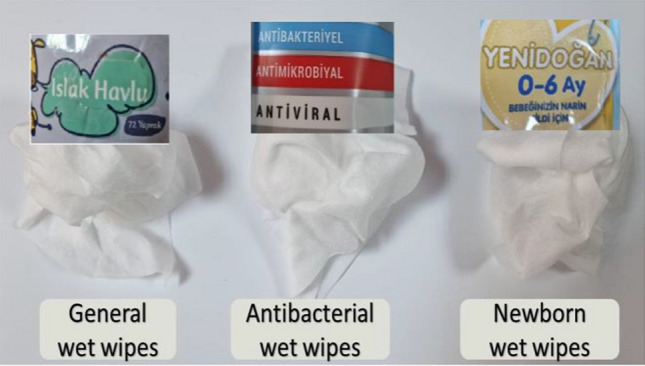
The WWs used in the study
Fig. 10.

FT-IR images of WWs used in Turkey
Based on the results of the FT-IR analysis, the absorbance peaks of the newborn, antibacterial, and more generally used WWs were identified as 2950, 1712, 1561, 1241, and 1093 cm–1, respectively [47, 48]. The C–O ester stretching vibration band is observed at wavelengths 1093 and 1241 cm–1 [49]. This band corresponds to the degree of oxidation on the surface. However, the 1561 and 1712 cm–1 C = O band represents the carbonyl group [50]. Furthermore, the 2950 cm–1 absorbance peak demonstrates the presence of the–CH2 methylene group together with symmetrical and asymmetric stretching vibrations [51]. FT-IR spectroscopy shows the functional bond structure of wet wipes as well as percentage polymer distribution. While it has 37.5% viscose, 30% polyester, 7.5% lycra, 23.1% Polypyrrole content in NewBorn WW, it has 56.7% polyester, 30.6% cotton and 21.8% Poly (oxyethylene) alkyl amide content in general-use WW with a polymer structure. It has been determined from the reference library that it is 100% polyester in antibacterial WW. Content percentages of polymer and other components determined by FT-IR spectroscopy for newborn, antibacterial, and more generally used WWs are presented in Table 2.
Table 2.
Percentage distribution of polymers and the other components in WWs
| Type of WW | Polyester % | Poly (oxyethylene) Alkyl amide % |
Polypyrrole % | Viscose % | Lycra % | Cotton % |
|---|---|---|---|---|---|---|
| Newborn WW | 30 | – | 23.1 | 37.5 | 7.5 | – |
| Antibacterial WW | 100 | – | – | – | – | – |
| General use WW | 56.7 | 21.8 | – | – | – | 30.6 |
Based on these data, polyester was accepted as the primary polymer structure most frequently employed in WW content, and as the base polymer type in constructing the present study’s relevant computations and evaluating scenarios. The amount of polymer that will create plastic waste load was also calculated by assuming that each WW, which is currently in use in 2021 and predicted to be used in 2040 and 2060, has a polymer content of a minimum of 30% and a maximum of 90% [10]. With the assumption that the content of each WW contains at least 30% polymer, it was estimated that 120 T, 190 T, and 208 T polymer substances per day would create a plastic waste load in the years 2021, 2040, and 2060, respectively. On the other hand, based on the assumption that polymer materials account for 90% of the content of WWs, it was estimated that 360 T, 568 T, and 623 T polymer materials would create a plastic waste load each day in the years 2021, 2040, and 2060, respectively (Fig. 11). The resulting waste load indicates the pressure of microplastic pollution originating from wet wipes by a minimum of 0.13% and a maximum of 0.4% of the total amount of domestic waste generated.
Fig. 11.
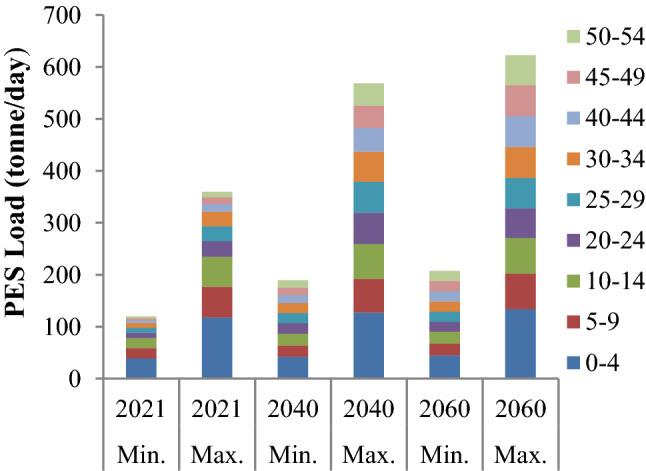
Daily PES load from WWs
EU member states take specific directives, strategies, and regulation (in chronological order) measures to combat plastic pollution. However, while the wastes that can be managed are taken under control, there is no directive regarding wet wipes with the potential for microplastic pollution. This may be a signal of a hidden danger for the receiving environments and living spaces. Thus, it may be also an element of environmental oppression. WWs and hygiene products are thought to be the source of the majority of microplastics found in sewage and sediments [7]. In addition, the development of plastic waste reduction methods in terms of the plastic waste load created by WWs, research on the situation and effects of plastic spills in the marine environment should be included in the emergency action plans [52]. Some other micro-polymer structures to be detected in the next century will not have an additional impact on the rate of waste originating from WWs, and personal habits will continue to put more pressure on microplastic pollution over time.
Conclusion
The stress created by the plastic waste load was at significant levels even before the COVID-19 pandemic. This study has revealed that the changes in hygiene habits caused by COVID-19 constitute an important activator for long-term changes in plastic waste management studies worldwide. The principal goal of this study was to calculate waste composition projections for the years 2040–2060 according to WW usage habits. Based on the computed data, the volume of WW-related waste will expand to an alarming level in 2040 and afterward. However, it should be emphasized that these scenarios were generated solely considering usage for hygiene purposes and with the minimum number of WWs potentially used.
WWs, which are used for a variety of purposes in many different contexts ranging from kitchen cleaning to car washing, contain not only polymers but also various chemicals. For instance, there are pre-impregnated industrial-grade cleaning wipes with a powerful cleaning fluid that dissolves dirt as the high-performance fabric absorbs the residue. Industrial wipes may clean a vast range of though-to-clean substances from hands, tools, and surfaces, including grime, grease, oil- and water-based paints and coatings, adhesives, silicone, and acrylic sealants, polyfoam, epoxy, oil, tar, and more.
Assuming that these products are used at the same rate as the anticipated WW usage in this study, the waste generated by WWs will increase from 400 T per day to 700 T per day in the year 2060. Along with its consequences for the ecosystem, finding sustainable and long-term solutions for the storage and disposal of this massive volume of waste is an emergency of the utmost importance.
Also put substantial pressure on the ecosystem since they are light, easy to use, and discarded; in other words, they directly pervade natural processes. Hence, the polymer structures utilized in their contents and the permanence of biodegradable and non-biodegradable substances in nature have become a severe concern in recent years.
In parallel with the WW waste volume detected in this study, it was also found that the polymer material, which is currently at least 120 T/day, will put 208 tons of pressure on nature in the future. Since WWs contain 90% polymer, it has been estimated that a maximum of 360 T of polymers currently affect the environment each day and this amount will rise to 623 T in the future. Emergency measures and restrictions should be implemented to prevent this massive build-up of polymers. Since the structures of wet wipes are generally composed of plastic types such as PP and PES, they have the potential for microplastic pollution from the moment they are released into nature. Therefore, it is recommended to change the wet wipe usage habits immediately. In addition, controls and restrictions should be imposed on the use and production of wet wipes by administrative administrations.
The measures taken in Europe for preventing microplastic pollution with public participation have paved the way for restrictions and sanctions regarding the use of microplastics in 2021. Within the scope of the ‘zero waste’ movement, projects to raise public awareness have been successfully practiced and supported by public institutions in Turkey as well. Awareness-raising practices have been carried out in primary and secondary schools. However, the changes observed in hygiene habits support the predictions that WW-related microplastic pollution will continue to rise in the coming years.
In addition, some WW manufacturers use alcohol-containing preservatives to easily kill bacteria and enzymes responsible for nutrient cycling in different ecosystems. Besides preservatives such as methylisothiazolinone are also mixed to prevent bacterial or fungal growth. More recently, different chemical materials are added to prevent virus-related infections, as well as treating the products with emollients, lotions, or perfumes to adjust the tactile and olfactory properties and support these substances with water or other liquids (e.g., isopropyl alcohol) according to usage purpose. All these effects result in irreversible damage in nature.
Although this study focused on scenarios arising from the polymer structures in the content of WWs, no other evaluation was made for the chemicals utilized at substantially different concentrations. We should fight not only against polymer structures but also against other chemicals that have a significant impact on ecosystems’ health. Further studies on degradable WWs (‘100% viscose fiber’), which are yet to gain wide acceptance in the market, should be encouraged as soon as possible.
Acknowledgements
The authors gratefully acknowledge the TurkStat for the data source.
Author contributions
RK: corresponding author, contributed data or analysis tools. AA: methodology, scenario analysis. EUD: collected the sampling data and performed laboratory analysis. NS: conceptualization, study design, definition of intellectual content. All the authors: writing—review and editing manuscript.
Funding
The authors declare that no funds, grants, or other support were received during the preparation of this manuscript.
Data availability
The datasets generated during and/or analyzed during the current study are available from the corresponding author on reasonable request.
Declarations
Conflict of interest
The authors declare no conflict of interest.
Ethical approval
Not applicable.
Consent to participate
Not applicable.
Consent to publish
Not applicable.
Footnotes
Publisher's Note
Springer Nature remains neutral with regard to jurisdictional claims in published maps and institutional affiliations.
References
- 1.Pal Wipe Products (2021) Infection prevention everywhere surface cleaning. https://www.palinternational.com/en/healthcare/
- 2.Pulan S, Kaplan S, Ulusoy S. An investigation about liquid transfer characteristics of nonwoven wet wipes including natural components. J Text Eng. 2015;22(100):13–24. doi: 10.7216/1300759920152210002. [DOI] [Google Scholar]
- 3.Rengasamy RS. Composite non-woven materials: structure properties and applications. Amsterdam: Elsevier; 2014. Composite nonwovens in wipes. [Google Scholar]
- 4.Marsh RG and Duderstadt JM 2014 Cleansing composition and a wet wipe comprising the same. 89,40,675 B2, issued 2014
- 5.Touchet YL and Radovanovich PM (1994) Antimicrobially effective aqueous solution and preserved wet wipes using same. EP Patent No:0 619 074 Al., issued 1994
- 6.Pajda A (2018) Did you know wet wipes are made with plastic? This is why the UK wants them banned. https://www.onegreenplanet.org/news/wet-wipes-made-plastic-uk-wants-banned/
- 7.Briain OÓ, Mendes AR, McCarron S, Healy MG, Morrison L. The role of wet wipes and sanitary towels as a source of white microplastic fibres in the marine environment. Water Res. 2020;182:116021. doi: 10.1016/j.watres.2020.116021. [DOI] [PubMed] [Google Scholar]
- 8.Hamouda T, Ibrahim HM, Kafafy HH, Mashaly HM, Mohammed NH, Aly NM. Preparation of cellulose-based wipes treated with antimicrobial and antiviral silver nanoparticles as novel effective high-performance coronavirus fighter. Int J Biol Macromol. 2021;181:990–1002. doi: 10.1016/j.ijbiomac.2021.04.071. [DOI] [PMC free article] [PubMed] [Google Scholar]
- 9.Suaria G, Perold V, Lee JR, Lebouard F, Aliani S, Ryan PG. Floating macro- and microplastics around the Southern Ocean: results from the Antarctic circumnavigation expedition. Environ Int. 2020;136:105494. doi: 10.1016/j.envint.2020.105494. [DOI] [PubMed] [Google Scholar]
- 10.Zhang Y, Wen Z, Lin W, Hu Y, Kosajan V, Zhang T. Life-Cycle environmental ımpact assessment and plastic pollution prevention measures of wet wipes. Resour Conserv Recycl. 2021;174:105803. doi: 10.1016/j.resconrec.2021.105803. [DOI] [Google Scholar]
- 11.McGoran AR, Clark PF, Morritt D. Presence of microplastic in the digestive tracts of European flounder, platichthys flesus, and European smelt, osmerus eperlanus, from the River Thames. Environ Pollut. 2017;220:744–751. doi: 10.1016/j.envpol.2016.09.078. [DOI] [PubMed] [Google Scholar]
- 12.Durukan S, Karadagli F. Physical characteristics, fiber compositions, and tensile properties of nonwoven wipes and toilet papers in relevance to what ıs flushable. Sci Total Environ. 2019;697:134135. doi: 10.1016/j.scitotenv.2019.134135. [DOI] [PubMed] [Google Scholar]
- 13.Hu T, Shen M, Tang W. Wet wipes and disposable surgical masks are becoming new sources of fiber microplastic pollution during global Covıd-19. Environ Sci Pollut Res. 2021 doi: 10.1007/s11356-021-17408-3. [DOI] [PMC free article] [PubMed] [Google Scholar]
- 14.Clinic Cleveland (2021) No tido disinfecting wipes kill COVID-19? Health essentials articlestle. https://health.clevelandclinic.org/do-disinfecting-wipes-kill-the-coronavirus/
- 15.Hada JS. New trends in non-woven wet wipes. Int J Mod Trends Sci Technol. 2020;06(9S):89–96. doi: 10.46501/IJMTST0609S15. [DOI] [Google Scholar]
- 16.ReportLinker (2022) Wipes global market report 2021 : COVID- 19 growth and change to 2030 no. March 2019: 2019–22
- 17.Shruti VC, Pérez-Guevara F, Kutralam-Muniasamy G. Wet wipes contribution to microfiber contamination under COVID-19 Era: an important but overlooked problem. Environ Chall. 2021;5:100267. doi: 10.1016/j.envc.2021.100267. [DOI] [PMC free article] [PubMed] [Google Scholar]
- 18.Porter G (2021) America’s obsession with wipes ıs tearing up sewer systems. www.bloomberg.com/news/articles/2021-03-26/
- 19.WHO (2020) Water, sanitation, hygiene, and waste management for SARS-CoV-2, the virus that causes COVID-19. Interim Guidance, no. 29 July: 1–11. https://www.who.int/publications/i/item/water-sanitation-hygiene-and-waste-management-for-the-covid-19-virus-interim-guidance
- 20.Republic of Turkey Ministry of Health General Directorate of Health Promotion (2012) Turkey Hand Washing Research
- 21.Marian J (2022) Study reveals hand-washing habits of Europeans, 48–50. https://jakubmarian.com/a-study-reveals-how-many-europeans-wash-their-hands-with-soap/
- 22.Uğurlu YK, Durgun H, Nemutlu E, Kurd O. Assessment of knowledge and attitude of social handwashing in Turkey population during COVID-19 pandemic. J Contemp Med. 2020;10(4):617–624. [Google Scholar]
- 23.Pektaş S, Semiz BB. Investigating the effects of factors that influence the attitudes of consumers towards private label products on their repurchase intention: a study on personal care products. Turkish J Mark. 2021;6(1):32–50. doi: 10.30685/tujom.v6i1.112. [DOI] [Google Scholar]
- 24.Bozyiğit S, Madran C. The role of child rearing attitudes of maternal on the socialization as an environment conscious consumer of children. MANAS J Soc Stud. 2018;7(2):173–196. [Google Scholar]
- 25.Koenig MA, Doebel S. Children’s understanding of unreliability: evidence for a negativity bias. In: Banaji MR, Gelman SA, editors. Navigating the social world. New York: Oxford University Press; 2013. pp. 235–240. [Google Scholar]
- 26.National Academies of Sciences Engineering and Medicine . A unifying foundation. Washington, DC: The National Academies Press; 2015. Transforming the workforce for children birth through age 8. [PubMed] [Google Scholar]
- 27.Voros J. A generic foresight process framework. Foresight. 2003;5(3):10–21. doi: 10.1108/14636680310698379. [DOI] [Google Scholar]
- 28.Aral N, Gülen B. Child Development. Istanbul: YA-PA Publishing Inc; 2011. [Google Scholar]
- 29.TUIK (2021a) Address based population registration system results. https://data.tuik.gov.tr/Kategori/GetKategori?p=nufus-ve-demografi-109&dil=1
- 30.TUIK (2021b) The data: coverage, periodicity and timeliness. https://data.tuik.gov.tr/Bulten/DownloadIstatistik
- 31.Dey S, Purdon M, Kirsch T, Helbich H, Kerr K, Li L, Zhou S. Exposure factor considerations for safety evaluation of modern disposable diapers. Regul Toxicol Pharmacol. 2016;81:183–193. doi: 10.1016/j.yrtph.2016.08.017. [DOI] [PubMed] [Google Scholar]
- 32.Didişen NA, Yavuz B, Bolışık ZB. The investigation of using wet wipes in the care of hospitalized children mothers in children’s hospitals. J Ege Univ Fac Nurs. 2014;30(2):91–100. [Google Scholar]
- 33.Kurt H (2019) Prevalence of diaper rash and factors affecting 0–24 months in children. Harran University, Institute of Health Sciences, Department of Nursing
- 34.Dey S, Carr GJ, Li L, Brink S, Zhou S. Probabilistic monte carlo estimation for quantitative exposure assessment of lotion transfer via baby wipes usage. Regul Toxicol Pharmacol. 2016;79:54–63. doi: 10.1016/j.yrtph.2016.05.006. [DOI] [PubMed] [Google Scholar]
- 35.Lee E, Yun J, Ha J, Park BC, Park GH, Kim HR, Hong SP, Kim KB, Kim MH. Assessment of exposure for baby cosmetic care products in a Korean population. Food Chem Toxicol. 2017;106:107–113. doi: 10.1016/j.fct.2017.05.039. [DOI] [PubMed] [Google Scholar]
- 36.Zhang Y, Wen Z, Hu Y, Zhang T. Waste flow of wet wipes and decision-making mechanism for consumers’ discarding behaviors. J Clean Prod. 2022;364:132684. doi: 10.1016/j.jclepro.2022.132684. [DOI] [Google Scholar]
- 37.Jung MR, Horgen FD, Orski SV, Rodriguez V, Beers CKL, Balazs GH, Jones TT, Work TM, Brignac KC, Royer SJ, Hyrenbach KD, Jensen BA, Lynch JM. Validation of ATR FT-IR to identify polymers of plastic marine debris, including those ingested by marine organisms. Mar Pollut Bull. 2018;127:704–716. doi: 10.1016/j.marpolbul.2017.12.061. [DOI] [PubMed] [Google Scholar]
- 38.Nielsen RK, Fletcher R, Newman N, Brennen JS and Howard PN 2020 Navigating the ‘infodemic’: how people in six countries access and rate news and information about coronavirus. Reuters Institute Report. Reuters Institute for the Study of Journalism. https://reutersinstitute.politics.ox.ac.uk/infodemic-how-people-six-countries-access-and-rate-news-and-information-about-coronavirus
- 39.Cabrera A and Garcia R (2019) The environmental and economic costs of single-use menstrual products. baby nappies and wet wipes. https://zerowasteeurope.eu/library/the-environmental-economic-costs-of-single-use-menstrual-products-baby-nappies-wet-wipes/
- 40.Letcher TM. Plastic waste and recycling. Amsterdam: Elsevier Inc; 2020. Introduction to plastic waste and recycling. [Google Scholar]
- 41.Meyer DJC, Anderson HC. Preadolescents and apparel purchasing: conformity to parents and peers in the consumer socialization process. J Soc Behav Personal. 2000;15(43):243–257. [Google Scholar]
- 42.Stryker S. Identity salience and role performance: the relevance of symbolic interaction theory for family research. J Marriage Fam. 1968;30(4):558–564. doi: 10.2307/349494. [DOI] [Google Scholar]
- 43.Stryker S. Identity theory and personality theory: mutual relevance. J Personal. 2007;75(6):1083–1102. doi: 10.1111/j.1467-6494.2007.00468.x. [DOI] [PubMed] [Google Scholar]
- 44.Badur F (2007) The effect of television advertising on children’s brand awareness: an application on food and drink advertisements. Atatürk University, Institute of social sciences, department of business administration
- 45.Kılıç C. Family education programs and their examples in Turkey. Abant Izzet Baysal Univ J. 2010;10(1):100–111. [Google Scholar]
- 46.Munoz LP, Baez AG, McKinney D, Garelick H. Characterization of ‘flushable’ and ‘non-flushable’ commercial wet wipes using microraman, FTIR spectroscopy and fluorescence microscopy: to flush or not to flush. Environ Sci Pollut Res. 2018;25(20):20268–20279. doi: 10.1007/s11356-018-2400-9. [DOI] [PubMed] [Google Scholar]
- 47.Ugolini A, Ungherese G, Ciofini M, Lapucci M, Camaiti M. Microplastic debris in sandhoppers. Estuar Coast Shelf Sci. 2013;129:19–22. doi: 10.1016/j.ecss.2013.05.026. [DOI] [Google Scholar]
- 48.Zhao J, Ran W, Teng J, Liu Y, Liu H, Yin X, Cao R, Wang Q. Microplastic pollution in sediments from the Bohai Sea and the Yellow Sea, China. Sci Total Environ. 2018;640–641:637–645. doi: 10.1016/j.scitotenv.2018.05.346. [DOI] [PubMed] [Google Scholar]
- 49.Paszkiewicz S, Szymczyk A, Pawlikowska D, Irska I, Taraghi I, Pilawka R, Gu J, Li X, Tu Y, Piesowicz E. synthesis and characterization of poly(ethylene terephthalate-: co -1,4–cyclohexanedimethylene terephtlatate)- block -poly(tetramethylene oxide) copolymers. RSC Adv. 2017;7(66):41745–41754. doi: 10.1039/c7ra07172h. [DOI] [Google Scholar]
- 50.Zimmerer C, Nagel J, Steiner G, Heinrich G. Nondestructive molecular characterization of polycarbonate–polyvinylamine composites after thermally induced aminolysis. Macromol Mater Eng. 2016;301(6):648–652. doi: 10.1002/mame.201500419. [DOI] [Google Scholar]
- 51.Xuguang S. The ınvestigation of chemical structure of coal macerals via transmitted-light FT-IR microspectroscopy. Spectrochimica Acta Part A Mol Biomol Spectrosc. 2005;62(1–3):557–564. doi: 10.1016/j.saa.2005.01.020. [DOI] [PubMed] [Google Scholar]
- 52.Wichai-utcha N, Chavalparit O. 3Rs Policy and plastic waste management in Thailand. J Mater Cycles Waste Manag. 2019;21:10–22. doi: 10.1007/s10163-018-0781-y. [DOI] [Google Scholar]
Associated Data
This section collects any data citations, data availability statements, or supplementary materials included in this article.
Data Availability Statement
The datasets generated during and/or analyzed during the current study are available from the corresponding author on reasonable request.




